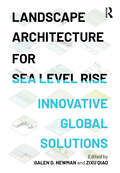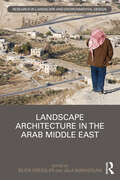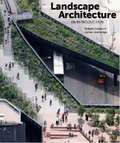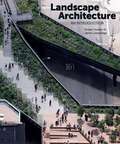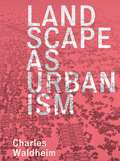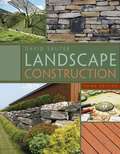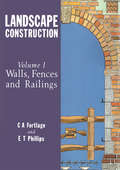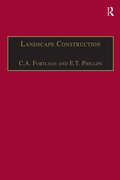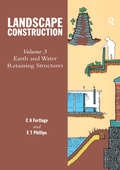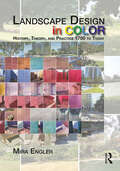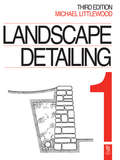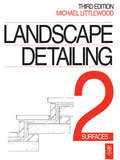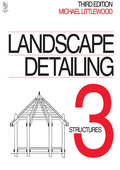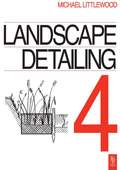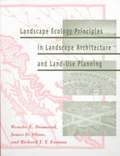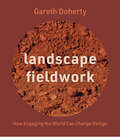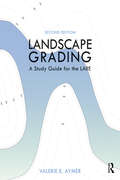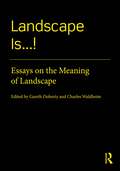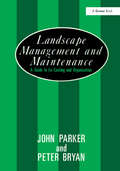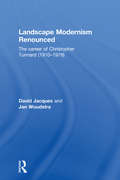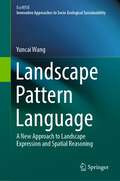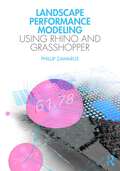- Table View
- List View
Landscape Architecture for Sea Level Rise: Innovative Global Solutions
by Galen D. Newman Zixu QiaoThis book assesses and illustrates innovative and practical world-wide measures for combating sea level rise from the profession of landscape architecture. The work explores how the appropriate mixture of integrated, multi-scalar flood protection mechanisms can reduce risks associated with flood events including sea level rise. Because sea level rise is a global issue, illustrative case studies performed from the United States, Korea, Australia, New Zealand, Thailand, Japan, China, and the Netherlands identify the structural (engineered), non-structural (nature-based), and hybrid mechanisms (mixed) used to combat sea level rise and increase flood resilience. The alternative flood risk reduction mechanisms are extracted and analyzed from each case study to develop and explain a set of design-based typologies to combat sea level rise which can then be applied to help proctor new and existing communities. It is important for those located within the current or future floodplain considering sea level rise and those responsible for land use, developmental, and population-related activities within these areas to strategically implement a series of integrated constructed and green infrastructure-based flood risk reduction mechanisms to adequately protect threatened areas. As a result, this book is beneficial to both academics and practitioners related to multiple design professions such as urban designers, urban planners, architects, real estate developers, and landscape architects.
Landscape Architecture in the Arab Middle East (Routledge Research in Landscape and Environmental Design)
by Jala Makhzoumi Beata DrekslerThis book explores the challenges facing landscape architecture in the Middle East. It supports the idea that landscape is a multifaceted idea, and examines landscapes architecture as an emerging profession in the region. The book also responds to the limitations of faulty translations of the English ‘landscape’ that, in turn, limit the professional potential in the region.The authors of the book see landscape as a way of beholding the world that is informed by place and culture. And because landscape is context specific, a landscape framing contextualizes a problem, be it community development, tourism, or nature conservation, to foster place and culture responsive perspectives. The nine chapters are grouped under four broad themes that reflect the multifaceted, ‘expansive’ framing that embraces landscape, natural and cultural heritage, people and livelihoods, and landscape and human rights.The authors recognize that a landscape framing is not the exclusive domain of landscape architecture, but can be applied by architects, planners, and environmentalists. The ideas advanced and issues discussed will be of interest to researchers, students, and practitioners in landscape architecture, architecture, planning, and urban design, as well as social and environmental scientists.
Landscape Architecture: An Introduction
by Robert Holden Jamie LiversedgeAimed at prospective and new students, this book gives a comprehensive introduction to the nature and practise of landscape architecture, the professional skills required and the latest developments. After discussing the history of the profession, the book explains the design process through principles such as hierarchy, human scale, unity, harmony, asymmetry, color, form, and texture. It looks at how design is represented through both drawing and modeling, and through digital techniques such as CAD and the use of GIS (Geographic Information Systems). This is followed by an examination of project management and landscape management techniques. Finally, the book explores educational and employment opportunities and the future of the profession in the context of climate change and sustainability. Illustrated with international examples of completed projects,Landscape Architecture provides an invaluable, one-stop resource for anyone considering studying or a career in this field.
Landscape Architecture: An Introduction
by Robert Holden Jamie LiversedgeAimed at prospective and new students, this book gives a comprehensive introduction to the nature and practice of landscape architecture, the professional skills required and the latest developments.After discussing the history of the profession, the book explains the design process through principles such as hierarchy, human scale, unity, harmony, asymmetry, colour, form and texture. It looks at how design is represented through both drawing and modelling, and through digital techniques such as CAD and the use of GIS (Geographic Information Systems). This is followed by an examination of project management and landscape management techniques. Finally, the book explores educational and employment opportunities and the future of the profession in the context of climate change and sustainability.Illustrated with international examples of completed projects, Landscape Architecture provides an invaluable, one-stop resource for anyone considering studying or a career in this field.
Landscape Architecture: An Introduction
by Robert HoldenAimed at prospective and new students, this book gives a comprehensive introduction to the nature and practice of landscape architecture, the professional skills required and the latest developments.After discussing the history of the profession, the book explains the design process through principles such as hierarchy, human scale, unity, harmony, asymmetry, colour, form and texture. It looks at how design is represented through both drawing and modelling, and through digital techniques such as CAD and the use of GIS (Geographic Information Systems). This is followed by an examination of project management and landscape management techniques. Finally, the book explores educational and employment opportunities and the future of the profession in the context of climate change and sustainability.Illustrated with international examples of completed projects, Landscape Architecture provides an invaluable, one-stop resource for anyone considering studying or a career in this field.
Landscape As Urbanism: A General Theory
by Charles WaldheimIt has become conventional to think of urbanism and landscape as opposing one another--or to think of landscape as merely providing temporary relief from urban life as shaped by buildings and infrastructure. <P><P>But, driven in part by environmental concerns, landscape has recently emerged as a model and medium for the city, with some theorists arguing that landscape architects are the urbanists of our age.
Landscape Construction
by David SauterLandscape Construction, 3rd edition, will help your students understand the process of construction and implementation of a multitude of exterior hardscape construction projects. This book begins with the preparation for construction and follows through to the installation of the final elements of the landscape project. Your students will appreciate the detailed discussions about site preparation, grading and drainage, utilities and irrigation, retaining wall construction, paving, exterior carpentry and fencing and free-standing walls. Such amenities as pools, ponds, and edging are also discussed in detail. All instructions are well supported by photos and illustrations. Each section contains thorough installation information for most of the contemporary materials used in today's landscapes. David Sauter has provided your students with expert perspective on materials and techniques, as well as easy-to-follow instructions.
Landscape Construction: Volume 1: Walls, Fences and Railings
by C. A. Fortlage E. T. PhillipsLandscape Construction Volume 1 deals with elements of landscape construction which are required to provide enclosure, privacy, demarcation of land, shelter and security. The elements discussed include free-standing brick and stone walls, fences, gates and railings. Fittings and finishes are also covered. Each section describes the materials, construction and constraints relevant to the subject and a large number of detailed figures and photographs supplement the text and help to illustrate the more important aspects. There is also a section on preservation treatment and painting. The current British Standard references are included.
Landscape Construction: Volume 2: Roads, Paving and Drainage
by E.T. Phillips C.A. FortlageLandscape Construction Volume 1 deals with elements of landscape construction which are required to provide enclosure, privacy, demarcation of land, shelter and security. The elements discussed include free-standing brick and stone walls, fences, gates and railings. Fittings and finishes are also covered. Each section describes the materials, construction and constraints relevant to the subject and a large number of detailed figures and photographs supplement the text and help to illustrate the more important aspects. There is also a section on preservation treatment and painting. The current British Standard references are included.
Landscape Construction: Volume 3: Earth and Water Retaining Structures
by E.T. PhillipsLandscape Construction Volume 1 deals with elements of landscape construction which are required to provide enclosure, privacy, demarcation of land, shelter and security. The elements discussed include free-standing brick and stone walls, fences, gates and railings. Fittings and finishes are also covered. Each section describes the materials, construction and constraints relevant to the subject and a large number of detailed figures and photographs supplement the text and help to illustrate the more important aspects. There is also a section on preservation treatment and painting. The current British Standard references are included.
Landscape Design in Color: History, Theory, and Practice 1750 to Today
by Mira EnglerArchitects, landscape architects and urban designers experiment with color and lighting effects in their daily professional practice. Over the past decade, there has been a reinvigorated discussion on color within architectural and cultural studies. Yet, scholarly enquiry within landscape architecture has been minimal despite its important role in landscape design. This book posits that though color and lighting effects appear natural, fleeting, and difficult to comprehend, the sensory palette of built landscapes and gardens has been carefully constructed to shape our experience and evoke meaning and place character. Landscape Design in Color: History, Theory, and Practice 1750 to Today is an inquiry into the themes, theories, and debates on color and its impact on practice in Western landscape architecture over the past three centuries. Divided into three key periods, each chapter in the book looks at the use of color in the written and built work of key prominent designers. The book investigates thematic juxtapositions such as: natural and artificial; color and line; design and draftsmanship; sensation and concept; imitation and translation; deception and display; and decoration and structure, and how these have appeared, faded, disappeared, and reappeared throughout the ages. Richly designed and illustrated in full color throughout, including color palettes, this book is a must-have resource for students, scholars, and design professionals in landscape architecture and its allied disciplines.
Landscape Design, Construction, and Maintenance
by Charles B. Schroeder Ronald J. BiondoNIMAC-sourced textbook
Landscape Detailing Volume 1: Enclosures
by Michael LittlewoodMichael Littlewood's Landscape Detailing is now well established as a valuable source of reference for architects, landscape architects, other professionals and students designing external works.Volume I, Enclosures, covers walls (free-standing, screen and retaining), fences, gates, barriers and bollards. Each section begins with technical guidance notes on design and construction and then provides a list of points against which specifications can be checked. This is followed by a set of drawn-to-scale detail sheets. These details can be traced for direct incorporation into the set of contract drawings. A list of relevant British Standards, references, bibliography and a list of associations and institutions indicate where further guidance can be obtained. As a ready reference for landscape designers and as an indispensable time-saving tool, Landscape Detailing is an essential for the design office.
Landscape Detailing Volume 2: Surfaces
by Michael LittlewoodAs a ready reference for landscape designers and as an indispensable time-saving tool, Landscape Detailing is an essential for the design office.Each section begins with technical guidance notes on design and construction and then provides a list of points against which specifications can be checked. This is followed by a set of drawn-to-scale details sheets. These details can be traced for direct incorporation into the set of contract drawings. A list of relevant British Standards, references, bibliography and a list of associations and institutions indicate where further guidance can be obtained.
Landscape Detailing Volume 3: Enclosures
by Michael LittlewoodMichael Littlewood's Landscape Detailing is now well established as a valuable source of reference for architects, landscape architects, other professionals and students designing external works. For this third edition it has been split into three volumes to give a greater depth of coverage than ever before.Volume 3 covers pergolas, arbours, arches, gazebos, summer houses, sheds, shelters, decks, footbridges, furniture and roofs. Each section begins with technical guidance notes on design and construction. This is followed by a set of drawn-to-scale detail sheets. These details can be traced for direct incorporation into the set of contract drawings. A list of relevant references, bibliography and a list of association and institutions indicate where further guidance can be obtained. A ready reference for landscape designers and an indispensable time-saving tool, Landscape Detailing is an essential for the design office.
Landscape Detailing Volume 4: Enclosures
by Michael LittlewoodWell established as a valuable source of reference for architects, landscape architects, professionals and students designin external works. This volume covers water features and offers drawings detailed to scale, unlike many of the other books on the market which only deal in sketch forms.Covers landscape ponds, streams and waterfalls, fountains, edges, bank protection, revetments, dams, weirs and sluices, island rafts and jetties and drainage. Each section begins with technical guidance notes on design and construction. This is followed by a set of drawn-to-scale detail sheets. These details can be traced for direct incorporation into the set of contract drawings. A ready reference for landscape designers and an indispensable time-saving tool, Landscape Detailing is an essential for the design office.
Landscape Ecology Principles in Landscape Architecture and Land-Use Planning
by Richard T. T. Forman Thomas C. Brown David M. Gillilan Wenche E. Dramstad James D. Olson Richard T. Forman Harvard University Graduate School of Design Staff Wenche DramstadLandscape ecology has emerged in the past decade as an important and useful tool for land-use planners and landscape architects. While professionals and scholars have begun to incorporate aspects of this new field into their work, there remains a need for a summary of key principles and how they might be applied in design and planning. This volume fills that need. It is a concise handbook that lists and illustrates key principles in the field, presenting specific examples of how the principles can be applied in a range of scales and diverse types of landscapes around the world. Chapters cover: patches -- size, number, and location edges and boundaries corridors and connectivity mosaics summaries of case studies from around the world
Landscape Fieldwork: How Engaging the World Can Change Design
by Gareth DohertyRefocusing on human inhabitants in landscape architecture Landscape architecture is at a crossroads. The ability to draw upon interdisciplinary perspectives and generate insights from the combined vantage points of design, environmental studies, and the social sciences puts it in a prime position to address the most pressing issues of our time, such as climate change and social inequality. Its current reliance on digital and technological solutions, however, has increasingly caused landscape architects to lose sight of the ways in which humans actually use spaces. And while landscapes are designed all over the world, the discipline remains inordinately centered on the Global North. Landscape Fieldwork alters that long-standing paradigm through real-life examples that provide tools for practitioners to engage more deeply with multidimensional, diverse landscapes and the communities that create, live in, and use them.
Landscape Grading: A Study Guide for the LARE
by Valerie E. AymerFor every element that we design in the landscape, there is a corresponding grading concept, and how these concepts are drawn together is what creates a site grading plan. This study guide explores these concepts in detail to help you learn how to grade with confidence in preparation for the Grading, Drainage and Construction Documentation section of the Landscape Architecture Registration Examination (LARE). This updated second edition is designed as a textbook for the landscape architecture student, a study guide for the professional studying for the LARE, and a refresher for licensed landscape architects. New to this edition: • Additional illustrations and explanations for grading plane surfaces and warped planes, swales, berms, retention ponds, and drain inlets; • Additional illustrations and explanations for grading paths, ramp landings, ramp/stair combinations and retaining walls; • A section on landscape and built element combinations, highlighting grading techniques for parking lots, culverts and sloping berms; • A section on landscape grading standards, recognizing soil cut and fill, determining pipe cover, finding FFE, and horizontal and vertical curves; • Updated information about the computer-based LARE test; • All sections updated to comply with current ADA guidelines; • An appendix highlighting metric standards and guidelines for accessibility design in Canada and the UK. With 223 original illustrations to aid the reader in understanding the grading concepts, including 32 end-of-chapter exercises and solutions to practice the concepts introduced in each chapter, and 10 grading vignettes that combine different concepts into more robust exercises, mimicking the difficulty level of questions on the LARE, this book is your comprehensive guide to landscape grading.
Landscape Graphics: Plan, Section, and Perspective Drawing of Landscape Spaces
by Grant ReidAnnouncing the new revised edition of the classic industry reference! Landscape Graphics is the architect's ultimate guide to all the basic graphics techniques used in landscape design and landscape architecture. Progressing from the basics into more sophisticated techniques, this guide offers clear instruction on graphic language and the design process, the basics of drafting, lettering, freehand drawing and conceptual diagramming, perspective drawing, section elevations, and more. It also features carefully sequenced exercises, a complete file of graphic symbols for sections and perspectives, and a handy appendix of conversions and equivalents.
Landscape Is...!: Essays on the Meaning of Landscape
by Charles Waldheim Gareth DohertyLandscape Is...! examines the implicit biases and received meanings of landscape. Following on from the previous publication Is Landscape…? which examined the plural and promiscuous identities of the landscape idea, this companion volume reflects upon the diverse and multiple meanings of landscape as a discipline, profession, and medium. This book is intended for academics, researchers, and students in landscape architecture and cognate disciplines. Chapters address various overlooked aspects of landscape that develop, disturb, and diversify received understandings of the field. Framed as an inquiry into the relationship of landscape to the forms of human subjectivity, the book features contributions from leading voices who challenge the contemporary understandings of the field in relation to capital and class, race and gender, power and politics, and more.
Landscape Management and Maintenance: A Guide to Its Costing and Organization
by John Parker Peter BryanWith increased public attention focused on the environment and government legislation on competition, landscape managers are coming under increasing pressure to adopt a more disciplined analytical approach to their work. Landscape Management and Maintenance will help you to set objectives for the use of your land, your manpower and your resources. The authors draw on their wide experience of different types of landscape management to give you clear examples of the methods and alternatives. At each stage they emphasise how to make cost effective choices, and achieve the best value for money.
Landscape Modernism Renounced: The Career of Christopher Tunnard (1910-1979)
by Jan Woudstra David JacquesBefore the Second World War landscape architect Christopher Tunnard was the first author on Modernism in Landscape in the English language, but later became alarmed by the destructive forces of Post-war reconstruction. Between the 1950s and the 1970s he was in the forefront of the movement to save the city, becoming an acclaimed author sympathetic to preservation. Ironically it was the Modernist ethos that he had so fervently advocated before the war that was the justification for the dismemberment of great cities by officials, engineers and planners. This was not the first time that Tunnard had to re-evaluate his principles, as he had done so in the 1930s in rejecting Arts-and-Crafts in favour of Modernism. This book tracks his changing ideology, by reference to his writings, his colleagues and his work. Christopher Tunnard is one of the most influential figures in Landscape Architecture and his journey is one that still resonates in the discipline today. His leading role in first embracing the tenets of Modernism and then moving away from to embrace a more conservationist approach can be seen in the success and impact on the profession of those with whom he worked and taught.
Landscape Pattern Language: A New Approach to Landscape Expression and Spatial Reasoning (EcoWISE)
by Yuncai WangThis book presents a landscape pattern language framework for describing landscape spaces and offers a new approach to landscape expression and spatial reasoning. In addition to describing a conceptual model of landscape pattern language and its inner logical connections, the book discusses the functionality of landscape pattern language from both local and universal perspectives—effectively demonstrating that it can be used to highlight the individuality and characteristics of landscape space shaping. Given its scope, the book offers a valuable resource for all graduate students, lecturers, researchers, and practitioners in the areas of landscape architecture, landscape planning, and regional planning, especially ecological planning and design.
Landscape Performance Modeling Using Rhino and Grasshopper
by Phillip ZawarusThis is a guidebook for landscape architects to learn the fundamental practices and use of the computational software Rhino 3D and the plugin Grasshopper for parametric modeling, landscape inventory, and performative analysis. This process visually connects intangible and abstract information with physical and spatial relationships to signify the impact ecological, climate, and cultural factors have on landscape performance and decision making. Each chapter begins with a summary of the performance method and its application in different projects, outlining the expected goals from industry standard equations and operations. Chapters cover parametric modeling scripts to measure ecosystem services of stormwater management, erosion control, tree benefits, outdoor comfort, accessibility, and many others. Using photographs, tables, and parametric scripts to create qualitative and quantitative representations of landscape performance and ecosystem services, readers will learn to communicate the impact and significance of their outputs. This book will be beneficial to educators, students, and professionals interested in using computational modeling as a performance assessment and graphic visualization tool.
